Visiting Can Tho

|
|
Ancient beauty at Binh Thuy Communal House
Coming to Can Tho City, a quiet area that tourists should not ignore is Binh Thuy Communal House, known in the past as Long Tuyen Communal House.
Located in Binh Thuy Ward, about five
kilometers from the center of Can Tho, the site is not as famous as other sites
in the city such as Binh Thuy Old House, Cai Rang Floating Market, However, the communal house, which has existed for over two centuries, will bring another side of Can Tho’s history with its fine architecture and antiques. Built in the 19th century, the Communal House was named Bon Canh Thanh Hoang on November 9th 1893 by King Tu Duc. Later the Communal House was dedicated to national heroes including Dinh Cong Trang, Nguyen Trung Truc, Bui Huu Nghia and Vo Huy Tap. It was completely renovated in 1910. If you are an architecture enthusiast, you will recognize that the communal house’s architecture is different from communal houses in the north. The front and the back buildings are square, and its side has six rows of columns, and all the columns’ bases are extra-wide, making these buildings more stable. The roofs of the two front buildings were built overlapping each other. The main temple at the rear has three roofs. The top of the roof is covered with statues of people, lions and fish. In the front of the building, there are cement columns. Inside the ancestor-worshipping house, there are altars dedicated to worship the animal gods. It is considered a valuable monument of art and architectural style in the newly-expanded south western area. Although it was built at the beginning of the 20th century, its architecture has many traditional characteristics with carved and engraved wooden boards. Bas-reliefs, lacquered boards and paralleled sentences or royal costumes and old paintings is an interesting area for art lovers. Another impressive thing is the attendance of ong tu (the guard) of the house. He is very old with white hair and slowcoach gait. He will accompany you around the house and show you where to take the best photographs. Some giant trees in the spacious yard shading the house make it more ancient and peaceful. The house is also a venue for traditional
ceremonies and festivals.
Source: The Saigon Times |
Visiting Can Tho

|
|
Can Tho City’s Nice Dish: Ba Khía Rang Me (Freshwater Crabs Cooked with Tamarind Sauce)
|
|
Mit Nai in Can Tho is worth an exploration
|
Excursion to Phong Dien Garden, Can Tho City (part 2)
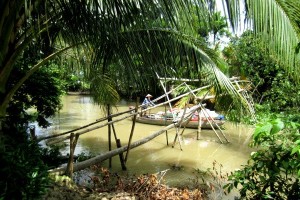 Here, it is very quiet in the early morning. For morning exercise, we walk along Ong De Rivulet. The further we go, the windier the road is. It closely follows the route of the rivulet. The scenery is very peaceful. Everyone seems to have a lot of work to care for their garden, so few people linger to look at the scenery like us. so desolate that few people loitering on the road. After breakfast with eggs, coffee, tea and a cup of hot fragrant cocoa, we rent bicycles to explore the village and go to the second homestay – Mr. Ba Xinh’s house. Here, it is very quiet in the early morning. For morning exercise, we walk along Ong De Rivulet. The further we go, the windier the road is. It closely follows the route of the rivulet. The scenery is very peaceful. Everyone seems to have a lot of work to care for their garden, so few people linger to look at the scenery like us. so desolate that few people loitering on the road. After breakfast with eggs, coffee, tea and a cup of hot fragrant cocoa, we rent bicycles to explore the village and go to the second homestay – Mr. Ba Xinh’s house.
|
Excursion to Phong Dien Garden, Can Tho City (part 1)
 Many visitors to Can Tho City, often visit Cai Rang floating markets, Phong Dien and return to air-conditioned hotels in town, Can Tho City, commonly known as The Capital City of the West. Usually they spend a night in a rather dry and cool bedroom there without knowing about an exciting alternative available for them: home stay tourism, where visitors stay, live and work together with the locals to learn more about the home culture here. It is fascinating to have a walk around the isles and live in the countryside typical of the rural southern delta. Many visitors to Can Tho City, often visit Cai Rang floating markets, Phong Dien and return to air-conditioned hotels in town, Can Tho City, commonly known as The Capital City of the West. Usually they spend a night in a rather dry and cool bedroom there without knowing about an exciting alternative available for them: home stay tourism, where visitors stay, live and work together with the locals to learn more about the home culture here. It is fascinating to have a walk around the isles and live in the countryside typical of the rural southern delta.
|
|
Coming to Can Tho City to enjoying Phong Dien Cocoa
|
Hotpot of Linh (Cirrhinus jullieni) Fish and Điên Điển (Sesbania Sesban) Flowers
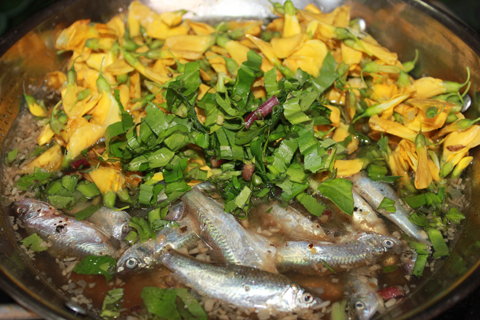 It goes without saying that Linh Fish and Dien Dien flowers are typical features of the Western South during the flood season. Westerners have been proud of the abundant produce from the nature, especially the dish called Lẩu cá linh hoa điên điển (Hotpot of C.jullieni Fish and Sesbania Sesban Flowers). To prepare a delicious hotpot, you should choose very fresh Linh Fish, then gut them thoroughly, clean and put them in a little for drainage. After that, the fish will be marinated with garlic, pepper, sugar and salt for about 10 minutes. It goes without saying that Linh Fish and Dien Dien flowers are typical features of the Western South during the flood season. Westerners have been proud of the abundant produce from the nature, especially the dish called Lẩu cá linh hoa điên điển (Hotpot of C.jullieni Fish and Sesbania Sesban Flowers). To prepare a delicious hotpot, you should choose very fresh Linh Fish, then gut them thoroughly, clean and put them in a little for drainage. After that, the fish will be marinated with garlic, pepper, sugar and salt for about 10 minutes.
|
|
Flourishing Phong Dien
|
Phong Dien Fine Rice Vermicelli
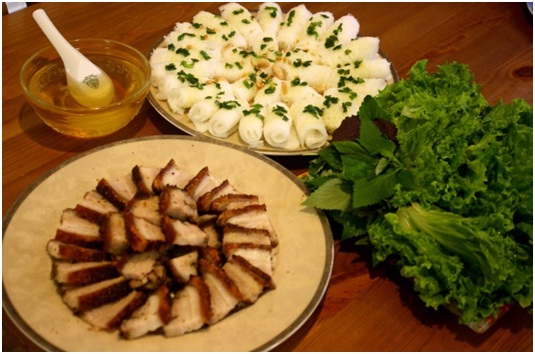 Whenever you come to Can Tho City and have a chance to visit Phong Dien District full of fruit laden orchards, enjoying a 1-day picnic tour to try working as local farmers doing harvest activities such as vegetable gardening, boating and fishing, you should not miss Gardener Minh Canh’s house to enjoy fine rice vermicelli with roast pork prepared by himself. Whenever you come to Can Tho City and have a chance to visit Phong Dien District full of fruit laden orchards, enjoying a 1-day picnic tour to try working as local farmers doing harvest activities such as vegetable gardening, boating and fishing, you should not miss Gardener Minh Canh’s house to enjoy fine rice vermicelli with roast pork prepared by himself.
|
|
Moc Quan Nguyen Trong Quyen - A Typical Vietnamese Hero
|
|
Luu Huu Phuoc - A Typical Vietnamese Hero
Luu Huu Phuoc was born on September 12th 1921 in a Confucian family in O Mon – Can Tho. At the age of 11, he finished elementary school. At the age of 16, after he finished junior high school, he continued his learning in Sai Gon. In two years 1940 - 1941, Luu Huu Phuoc together with Southern students made a pilgrimage to the sacred sites of the country such as Hung Temple, Tran Hung Dao Temple, Thanh Giong Temple, Bach Dang River , ... These places inspired so much emotions about the country and the pride of the national heroic spirit in him.
|
|
Chau Van Liem – A Typical Vietnamese Hero
|
|
Bui Huu Nghia - A Typical Vietnamese Hero
|
Well-known Com Ruou (Fermented Glutinous Rice Balls) in Thot Not
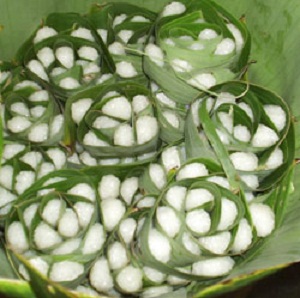 After we cross Thot Not Bridge, turn left and go for approximately 6 kilometers, we arrive at Trung Thanh Commune. Here almost all local people can show us how to go to the commune producing fermented glutinous rice balls. Following the instructions of the local people, we go more than a kilometer to Ba Dang Rivulet, along which there are 80-90 households making Com Ruou. This area is in Thanh Phuoc Village and Thanh Phuoc 2 Village of the edge of Thot Not District (Can Tho City). Ms. Huynh Thi Diem, Vice-Chair woman of Trung Thanh Women's Association, says, "Here, two out of every three households earn their living by making Com Ruou. After we cross Thot Not Bridge, turn left and go for approximately 6 kilometers, we arrive at Trung Thanh Commune. Here almost all local people can show us how to go to the commune producing fermented glutinous rice balls. Following the instructions of the local people, we go more than a kilometer to Ba Dang Rivulet, along which there are 80-90 households making Com Ruou. This area is in Thanh Phuoc Village and Thanh Phuoc 2 Village of the edge of Thot Not District (Can Tho City). Ms. Huynh Thi Diem, Vice-Chair woman of Trung Thanh Women's Association, says, "Here, two out of every three households earn their living by making Com Ruou.
|
|
The flower village is located in An Binh Commune and has a history of more than half a century. It usually becomes vibrant and bustle in many days before Tet holidays.
|
|
Knitting Portable Bamboo Traps (Lọp) at Thoi Long Commune
At Thoi Long Commune (O Mon - Can Tho) there is a trade of knitting portable bamboo traps for catching tiny shrimp (instrument for catching tiny shrimps). This trade is considered as an indispensible means of earning a living for thousands of farmers living in flood areas in the Mekong Delta in the yearly flood season. The commune of 300 households becomes bustling with knitting activity from May to September of the lunar year. Visitors to this place will witness how subtle and meticulous workers are in each step from making the brim, splitting bamboo splints, braided cuttings, weaving frame to fastening the body part and assembling them into a complete trap.
|
|
Cai Rang, Ba Lang, Vam Xang, Phong Dien
|
The Mekong Delta’s Taste in Hủ tiếu hấp - Steamed Rice Noodle
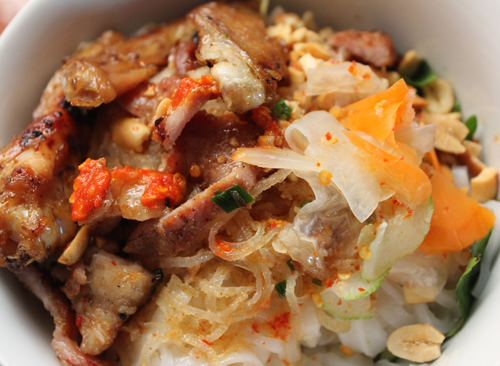 The Mekong Delta’s cuisine is famous for its rich and diverse culinary culture. Such dishes like pork-stuffed fried cake, pancake, rice noodles in fermented fish soup, fish noodle soup and so on are familiar to the South westerners’ and they have long been favored by people in Saigon and all over the world. The Mekong Delta’s cuisine is famous for its rich and diverse culinary culture. Such dishes like pork-stuffed fried cake, pancake, rice noodles in fermented fish soup, fish noodle soup and so on are familiar to the South westerners’ and they have long been favored by people in Saigon and all over the world.
|
|
Pancakes of Cái Sơn – Hàng Bàng
The name of Cái Sơn – Hàng Bàng, according to many people, this area has Cai Son small irrigation canal next to large malabar almond trees so this area has that name. Now, the small irrigation canal was quite large but large malabar almond trees is no longer appeared, however delicious pancakes and miniature fried phancakes remain as before.
|
|
Experience rustic homestay in Can Tho
|
|
Back to nature in Phong Dien
|
- Visiting Can Tho
- Typical hero
- Traditional village
- Landscape
- Traditional festival and Culture
- Cuisines
- Coffee
- Bar
- Specialties
- Eating places
- Shopping
- Useful information
- Supermarket
- Bookstore
- Entertainment
- Karaoke
- Hotel
- Taxi
- University and College
- Healthcare center
- Hotel
- Homestay
- Government asisstance
- Department of Foreign Affairs
- Can Tho Administrator of cuture, sport and tourism
- Police
COUNTER
Online:
Today:
Month:
Statistic:




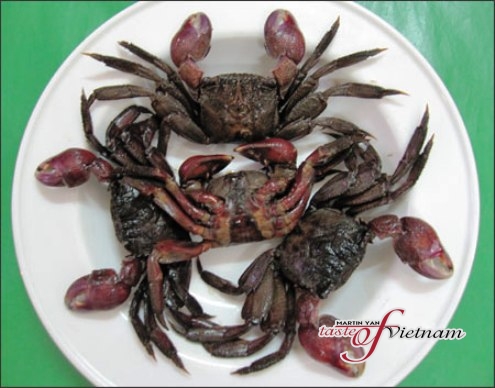 If you have an opportunity to visit Can Tho City, you should save time to go Dinh Tien Hoang Street, Thoi Binh Ward, Ninh Kieu District to enjoy many unique delicacies from Ba Khia cooked in various ways such as boiling, frying, steaming… This street is also called "Ba Khia Street" by the locals!
If you have an opportunity to visit Can Tho City, you should save time to go Dinh Tien Hoang Street, Thoi Binh Ward, Ninh Kieu District to enjoy many unique delicacies from Ba Khia cooked in various ways such as boiling, frying, steaming… This street is also called "Ba Khia Street" by the locals!  Mit Nai-Dan Tien area in Can Tho City includes many historical and cultural relics such as Mit Nai Market, Dan Tien Pagoda and Thay Cau Garden.
Mit Nai-Dan Tien area in Can Tho City includes many historical and cultural relics such as Mit Nai Market, Dan Tien Pagoda and Thay Cau Garden. 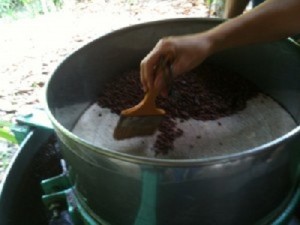 Phong Dien District is famous for its floating market, luxuriant orchards laden with all kinds of fruit, such as Ha Chau mulberries, oranges, tangerines, star apples, mangosteens, green apples, guavas ....
Phong Dien District is famous for its floating market, luxuriant orchards laden with all kinds of fruit, such as Ha Chau mulberries, oranges, tangerines, star apples, mangosteens, green apples, guavas .... 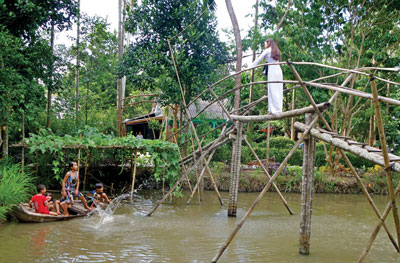 Phong Dien has long been renowned as a bustling trading place of rural residents. In recent years, Phong Dien District is constantly evolving to become a particular district for eco-tourism of Can Tho.
Phong Dien has long been renowned as a bustling trading place of rural residents. In recent years, Phong Dien District is constantly evolving to become a particular district for eco-tourism of Can Tho. 
 If you love me, give me money; don’t give me rice, which you will be laughed at by our neighbors
If you love me, give me money; don’t give me rice, which you will be laughed at by our neighbors 